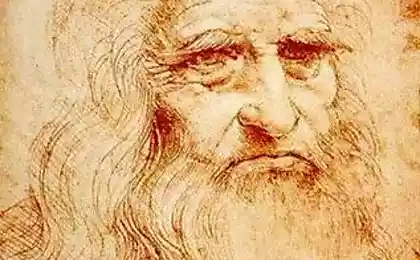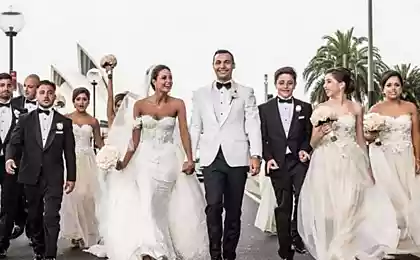807
One can understand the genius of how da Vinci anticipated the most important trends in the art of the XIX and XX centuries
In his book "Brain Leonardo" MD Leonard Schlein trying to understand the phenomenon of exclusivity Leonardo da Vinci and understand how he managed to achieve intellectual and creative development of this scale. We publish a chapter in which researchers compared the art of da Vinci with the works of the Impressionists, abstract and contemporary artists.
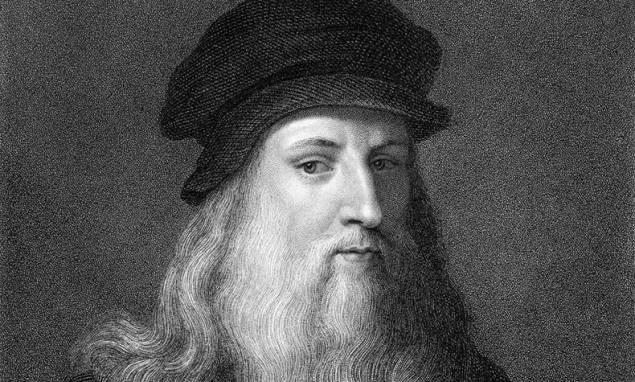
The first who raised the idea of Leonardo after the nearly 500-year period, during which the artists are subject to strict rules of perspective, composition and the choice of subjects and objects to the image, was Edouard Manet. Manet was in the forefront of a new generation of artists who have received their skills outside of the influential French Academy of Fine Arts.
In 1859, 27-year-old artist stood in front of his paintings and destroyed all that managed to create at this point. Stunned friends, he said: "From now on I will belong to its time and only work with what I see." However, his new works were very well received. Most critics, with some exceptions, spoke sharply to them, calling ugly and clumsy.
In France, while the success of the artist strongly depended on whether it was possible to receive from the hands of the venerable gray-bearded elders of the Academy, included in the jury of the annual Paris Salon, cherished the opportunity to present their work on this highly anticipated public event.
Changes already in the air, and many young artists have openly criticized the selection process, knowing that the jury is strongly opposed to them. In 1863, outraged constant refusals group of young artists organized a demonstrative exhibit, called Salon des Refuses.
Manet presented to her a few major works, but the central place was taken by his painting "Luncheon on the Grass." It was very shocking painting. Manet painted his favorite model Quiz Meran nonchalantly sitting on a blanket for a picnic completely naked, besides shamelessly staring at the viewer. Beside her, two men in business suits about something talk.
Moreover, they not only do not see a naked woman next door, but did not even look at each other. Critics have carried a picture of the nines. People came and laughed at her. Despite this, the "Breakfast on the grass" has collected the most viewers and received a lot of comments in the press. Critics accused the picture that it is not picturesque, and does not bear any moral, mythological, historical or religious ideas.
Among other artistic sins Mans and noted non-compliance with the rules of constructing perspective. In view of the prospects it turned out that the growth of women bathing distance should be about three meters. Besides Manet cost too freely with the direction of the light source and the position of the shadows. Critics have attributed this to the lack of a classical education in the Academy of Fine Arts, or lack of talent.
But in fact, Manet was a skilled draftsman and knew all the details of the image perspective. He deliberately did not use them in order to attract interest in the picture. Drinking Mans distorted perspectives have in common with Leonardo. Both artists are well aware that the optical tricks can give dramatic picture. In this sense, both artists, each in its time, marked the beginning and end of an era in perspectives of Western art.
The books on the history of art has repeatedly described the hype around the "Breakfast on the grass", but few people know that Manet placed equally outrageous work on a nearby wall: "Mademoiselle V. dressed matador" (1862). The visitors went from one wall to the other, and a comparison of the same model in the nude and dressed as a man, the most macho of all conceivable, enhances their appearance. (As we shall see, acceptance of sexual ambiguity exploited and Leonardo.)
Mans it was not enough: he stressed confused viewers, depriving their matadorshu underfoot support. Based on the background, it is the arena for a bullfight, but the picture can not see where it is Mademoiselle. It seems that it is almost floating in the air! Many paintings
Manet depicted a lone figure - and also with minimal or conflicting hints for the future ( "Piper", "Woman with Parrot" and "Dead bullfighter"). Just as in the case of a portrait of female matador, looking at these paintings, the viewer can not determine exactly what the relative positions of figures foreground and background.
The last picture of Leonardo - "John the Baptist" (it will be considered in detail in a later chapter), completely devoid of the background, it does not allow to determine where there is a saint. After Leonardo Manet was not the artists, depicting a figure with no background.
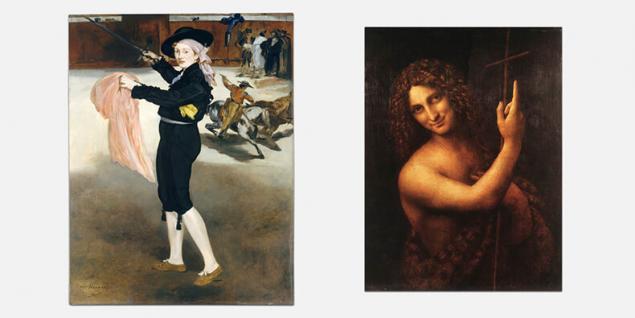
Edouard Manet, "Mademoiselle C. Espada in a suit"; Leonardo da Vinci, "John the Baptist»
In the early 1870s the opportunity to wear the paint with them and the invention of the collapsible easel led by the French artist Claude Monet to the idea to abandon the studio and go on nature, to write their sites and landscapes in the open air (from the French en plein air -. «Outdoors "). Such a change in the working environment was truly revolutionary.
Instead of planning, study, work on preparatory sketches and build the track in often poorly lit studio, Monet chose to work in nature, trying to capture scenes and landscapes seen in vivo. Monet tried to convey on canvas brief moment of first impression (fr. Impression), so the critics have called this line of Impressionism.
In previous centuries were not artists who have experimented with this technique. But is drawing Tuscan countryside, made by Leonardo da Vinci in the open air in 1473, can not be considered the first impressionist work in Western art? Leonardo anticipated is an important area in the end of XIX century painting by as much as four hundred years.
Another giant of the era of the end of the century painters (Fin de siècle) was Paul Cezanne. In the late 1880s he began a series of still lifes that are markedly different from what Western artists have done before. Audiences and critics were standing in front of his paintings, not knowing how to "read».
The problem was that they were trying to treat the work of Cezanne within restricted views, which were considered the norm for hundreds of years. Each subject would like Cezanne composition showed a different angle. In essence Cezanne provides viewers with the opportunity to look at a still life at the same time from different angles. Such a bizarre understanding of the rules prospects paved the way for more radical changes.
In 1904, 22-year-old Spanish artist Pablo Picasso moved to Paris, where he teamed up with another young painter Georges Braque. Together they rocked the art world to its very foundations by inventing a new look at the painting, giving up completely from all that has been previously.
Picasso resolutely declared: "We must destroy modern art." Art critic Louis voxel condemned the new style of Picasso and Braque and sarcastically called them a heap of pictures of "little cubes". So the name "Cubism". Although most critics initially cold took this style, cubism created a furore in the art world.
Critics alternately annoyed, then poured the oil of finding signs of Cubism, even in the early Cezanne, although nothing of the kind could be in the works of any previous artists. Once in the train compartment by a neighbor I asked Picasso why he did not draw people in such a way "as they look in reality." Picasso asked what he meant by that. In response, the man showed a photograph and said: "This is my wife." Picasso said: "Is it so small and flat»
Probably, not expecting to find that there was a certain artist, anticipating cubism early as the Renaissance, the critics did not look far into the past. Meanwhile, Leonardo, like Cézanne, Picasso and Braque, felt monocular sight limitations inherent in the use of the rules prospects.
He was looking for ways to show the view of the same object at the same time with many parties. He needed the best possible way to show the relationship between the parts that make up a whole. The need to resort to such an optical reception was caused by anatomical autopsy conducted Leonardo.
He was the first artist to comprehensively illustrated the internal organs of the human body. Although these figures are only technical in nature, they are by all standards can be considered masterpieces, and many critics did not hesitate this is how they are called.
Leonardo invented the exploded view an object method, thereby allowing the problem of simultaneous reflection of various aspects of the anatomical features and the relative position of neighboring structures. He drew on page one and the same thing a bit from different angles, so that the viewer could imagine at the same time some of his parties.
In the drawings of Leonardo and cubist paintings of Picasso and Braque have inexplicable similarities. At the core of these works on the principle of describing the true nature of the object, or as it is called in Buddhism, so it is.
This line of art by Leonardo longer reflected his scientific interests, unlike the Cubists, who aspired to artistic deformation of familiar objects. Anatomical drawings of Leonardo, still lifes by Cézanne, cubist paintings of Picasso and Braque - all these were attempts to portray the visible world in a new way, freed from the shackles of powerful prospects
. Their findings were wonderful and revolutionary, and all of them were based on the same principle. For many centuries after Leonardo, until the beginning of the XX century, nobody has this problem. Another similarity between Cézanne innovations and Leonardo regards desire of Cézanne to capture the essence of the mountain range of Saint-Victoire in Provence.
He realized that by portraying the mountain with only one angle, you can not pass it as such. Beginning in 1890 and until his death in 1906, Cezanne created a series of views from different points of the mountain. The impression of the union of all of these paintings was to allow the viewer to get a holistic view of the mountain.
None of the Western artists have not attempted to show in this way the different sides of the same object. No one but one. Four centuries earlier Leonardo came up with a way to do such. At its anatomical picture he posted successive images of the same shoulder at different angles.
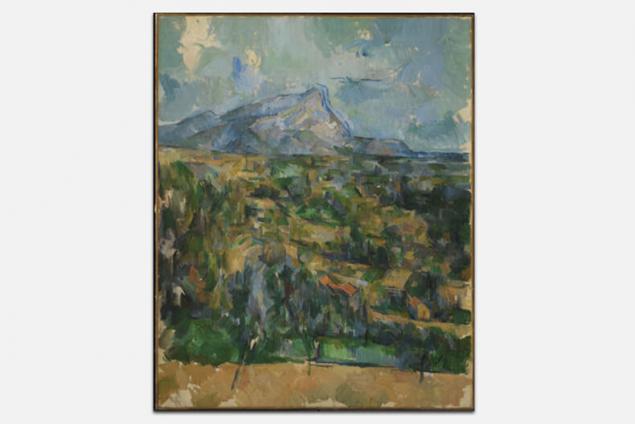
Paul Cezanne, "Montagne Sainte-Victoire»
The artist Wassily Kandinsky, who was born in Russia and lived in Europe, proposed a new approach, which has become a leader in the art of XX century. His discovery, as it often happens in art, in science, he was obliged to a happy occasion, but the breakthrough, which followed, was prepared so that the people were ready to look at the world in a new way.
In 1910, while working alone in his studio, Kandinsky was desperately trying to zoom in on the canvas to the image that was in his head. Finally, frustrated, he decided to take a break and go for a walk. No particular reason, before leaving he put the picture sideways.
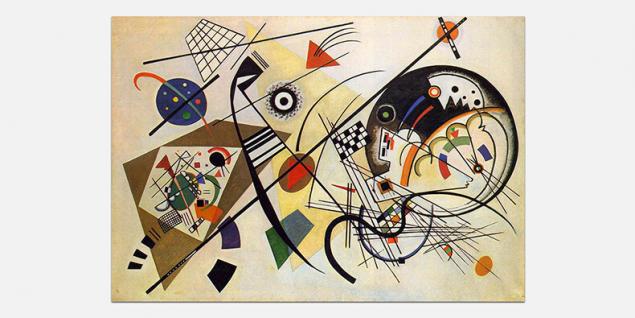
Wassily Kandinsky, "Cross the line»
Returning later, Kandinsky, deep in thought on some extraneous subject lingered in the doorway of the studio and looking up, he saw his unfinished work. For a moment he stood there, puzzled, did not recognize the picture. Then remembered that before leaving he turned it on 90 °.
Upon reflection, Kandinsky understood that fascinated his condition when he was unable to understand what is depicted in the picture. He experimented with a cloth, then placing it correctly, paying down the side. Kandinsky finally concluded that the picture becomes more interesting when it does not guessed a familiar image. So there was abstract.
Leonardo was interested in features abstract pattern. In his treatise on painting, which was published only in 1651, he wrote about the method of "inducement mind of the painter to new inventions." He advised artists:
That is, if you consider the walls, stained in different spots, or stones of varying mixtures. If you need to invent some kind of terrain, you can see there the similarity of different landscapes, adorned with mountains, rivers, rocks, trees, vast plains, valleys and hills in various ways; In addition, you can see there are different battle, quick movements of strange shapes, facial expressions, clothes and an infinite number of things that you can bring to the whole and good shape; with such walls and blends of the same thing happens as with the bell ringing - in it you will find beats any name or word that you imagine
. After World War II the United States has formed a new type of abstract artist. Jackson Pollock, the ideologue and one of the lead authors of abstract expressionism, has set itself the ambitious task: to capture on canvas the essence of the process of creating the painting. The process involves the painting of the artist, who is holding a brush or something similar and methodically applied to the surface smear for smear. How to capture the essence of movement on the canvas, which ultimately remain static? Pollock decision was truly a genius: he refused to use brushes and the canvas stretched on the floor. Usually accurate movement of the hand and fingers artist made sweeping: he sprayed, watered and metal paint on the canvas. The result was a color pattern, which, despite its chaotic, had a strange beauty and integrity.
Critics praised the revolutionary achievements of abstract, noting that this area has not climbed above no Western artist. But if they overlooked something important? At the end of the life of Leonardo he began experimenting with art, deprived of familiar images.
Being depressed because of numerous failures, health problems and other troubles, Leonardo began to think about what will happen when the world ends. He began a series of apocalyptic ink drawings, which depicted the great flood, washing away all the evil which, according to Leonardo, is inextricably entwined with humanity.
In these fantastic drawings by Leonardo blurs the line between objects and terrain. Walls falling water, flooded the world in these figures are remarkably similar to "Autumn Rhythm (Number 30)" Pollock. Moreover, Leonardo advised other artists throwing a sponge soaked in paint on the wall, anticipating the way Pollock.
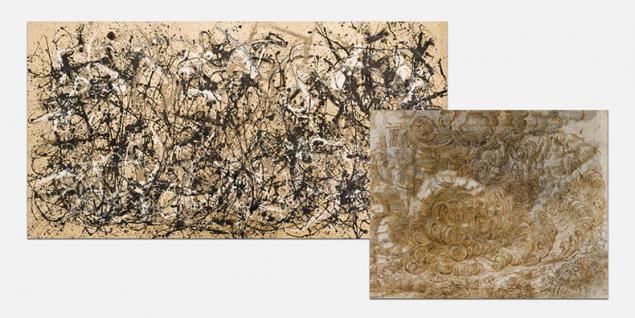
Jackson Pollock, "Autumn Rhythm (Number 30)"; Leonardo da Vinci, "The Flood»
Leonardo left behind a huge number of unfinished works. In art there are many plausible hypotheses about the strange habits. One such speculation could not have imagined before the advent of modern art. If the work is not completed on the canvas, the viewer can invent it with the help of his imagination.
It can be partially explained by the incompleteness of the two paintings is very strong, "Adoration of the Magi" (1481) and "Saint Jerome" (1481). None of the Western painters to works by Cezanne Paul in 1890 and Henri Matisse in the early 1900s, especially not left on the canvas blank, unpainted areas with the intention that the viewer fills in these fragments.
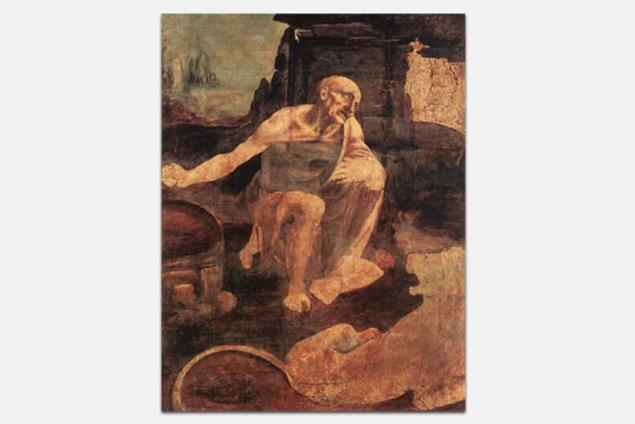
Leonardo da Vinci's "St. Jerome»
In bringing sfumato technique to the extreme, Leonardo began to blur the contours of the figures, even the subtle blurring the boundaries between the figures and the surrounding background. As the work on the painting was becoming less clear where one ends and another begins. Before him, artists initially prepared composition of the picture, outlining the shape, and then painted over their color.
This allowed painters to see the picture as a scene filled with models of figures aligned along the lines of perspective. Leonardo abandoned this technology, and thanks to the skilful blurring the boundaries between foreground and background of his picture is more realistic and at the same time mysterious, making them unique.
He introduced into his painting principle that before was considered a sign of poor quality. This principle of artistic uncertainty Leonardo began to use at a time when other artists held the opposite point of view - do not leave anything to the imagination and carefully write down every detail
. In his treatise on painting by Leonardo wrote that the outline of a shape is not part of either the body or the space around it. Despite this observation, the artists and the audience were assured that the contours must designate border. Почти 500 лет спустя Генри Мур понял, что отчетливая граница между массой объекта и окружающим его пространством — иллюзия.
Он выразил эту непростую идею в своих плавных, словно текущих линиях скульптур, как, например, «Внутренние и внешние формы» (1953–1954), где пространство вливается в тело и, наоборот, тело окружает пустое пространство так, что границы между ними размыты. Мур хотел, чтобы зритель воспринял идею слияния пространства с телом. Они влияют друг на друга и наполняют друг друга.
Те немногие физики, кто понимает идеи Эйнштейна, могли бы прийти к аналогичному выводу. Леонардо постиг этот принцип на пол тысячелетия раньше. Леонардо был художником, любящим парадоксы. Он писал книги загадок и декламировал парадоксальные стихи при дворе.
Валуны, образующие потолок пещеры на картине «Мадонна в скалах», удивительным образом напоминают камни, парящие в небе, на картинах Рене Магритта. Еще один пример парадокса, которым Магритт мог бы искренне восхищаться, — это загадочная битва двух всадников на заднем плане «Поклонения волхвов».
В 1915 году психолог Эдгар Рубин представил публике свою знаменитую оптическую иллюзию: фигуру, которая кажется то вазой, то двумя лицами в профиль. Его интересовало, как зрительная система человека отделяет фигуру от фона. Когда Рубин просил испытуемых сконцентрироваться на лицах, они не видели вазы.
Когда их просили увидеть вазу, лица таинственным образом исчезали. Эта иллюзия так действует почти у всех, и только очень немногие могли видеть и лицо, и вазу одновременно. Работы Рубина, посвященные зрительному восприятию, сильно повлияли на художников и на публику.
Испанский художник Сальвадор Дали воплотил идею, научно выраженную Рубином, в произведении изобразительного искусства. В картине «Рынок рабов с исчезающим бюстом Вольтера» (1940) женщина на переднем плане наблюдает за происходящим на невольничьем рынке, где люди общаются на фоне арочного проема.
Две одетые в черно-белые рясы монашки образуют лицо (глаза, скулы, подбородок и шею) французского философа Вольтера, как он был изображен на бюсте Жана-Антуана Гудона в 1781 году. Арка — верхнюю часть головы Вольтера. Дали создал очень хитроумный вариант вазы Рубина. Можно видеть либо лицо Вольтера, либо двух монашек под аркой, но не то и другое одновременно.
В искусстве, предшествующем современному, Леонардо был единственным художником, увлекавшимся игрой с оптическими иллюзиями, — больше ни у кого мы не найдем никаких обманок такого типа, или тромплеев (от фр. trompe l’oeil, «обман зрения»). Лео Штейнберг в книге «Вечная Тайная вечеря Леонардо» заметил, что Леонардо написал на стенах элементы лепнины в той же манере, что и зрительная иллюзия Рубина. Они похожи на известный куб Неккера, и их также можно рассматривать двумя разными способами. Обе версии оптически правильны, но их нельзя увидеть одновременно.

The first who raised the idea of Leonardo after the nearly 500-year period, during which the artists are subject to strict rules of perspective, composition and the choice of subjects and objects to the image, was Edouard Manet. Manet was in the forefront of a new generation of artists who have received their skills outside of the influential French Academy of Fine Arts.
In 1859, 27-year-old artist stood in front of his paintings and destroyed all that managed to create at this point. Stunned friends, he said: "From now on I will belong to its time and only work with what I see." However, his new works were very well received. Most critics, with some exceptions, spoke sharply to them, calling ugly and clumsy.
In France, while the success of the artist strongly depended on whether it was possible to receive from the hands of the venerable gray-bearded elders of the Academy, included in the jury of the annual Paris Salon, cherished the opportunity to present their work on this highly anticipated public event.
Changes already in the air, and many young artists have openly criticized the selection process, knowing that the jury is strongly opposed to them. In 1863, outraged constant refusals group of young artists organized a demonstrative exhibit, called Salon des Refuses.
Manet presented to her a few major works, but the central place was taken by his painting "Luncheon on the Grass." It was very shocking painting. Manet painted his favorite model Quiz Meran nonchalantly sitting on a blanket for a picnic completely naked, besides shamelessly staring at the viewer. Beside her, two men in business suits about something talk.
Moreover, they not only do not see a naked woman next door, but did not even look at each other. Critics have carried a picture of the nines. People came and laughed at her. Despite this, the "Breakfast on the grass" has collected the most viewers and received a lot of comments in the press. Critics accused the picture that it is not picturesque, and does not bear any moral, mythological, historical or religious ideas.
Among other artistic sins Mans and noted non-compliance with the rules of constructing perspective. In view of the prospects it turned out that the growth of women bathing distance should be about three meters. Besides Manet cost too freely with the direction of the light source and the position of the shadows. Critics have attributed this to the lack of a classical education in the Academy of Fine Arts, or lack of talent.
But in fact, Manet was a skilled draftsman and knew all the details of the image perspective. He deliberately did not use them in order to attract interest in the picture. Drinking Mans distorted perspectives have in common with Leonardo. Both artists are well aware that the optical tricks can give dramatic picture. In this sense, both artists, each in its time, marked the beginning and end of an era in perspectives of Western art.
The books on the history of art has repeatedly described the hype around the "Breakfast on the grass", but few people know that Manet placed equally outrageous work on a nearby wall: "Mademoiselle V. dressed matador" (1862). The visitors went from one wall to the other, and a comparison of the same model in the nude and dressed as a man, the most macho of all conceivable, enhances their appearance. (As we shall see, acceptance of sexual ambiguity exploited and Leonardo.)
Mans it was not enough: he stressed confused viewers, depriving their matadorshu underfoot support. Based on the background, it is the arena for a bullfight, but the picture can not see where it is Mademoiselle. It seems that it is almost floating in the air! Many paintings
Manet depicted a lone figure - and also with minimal or conflicting hints for the future ( "Piper", "Woman with Parrot" and "Dead bullfighter"). Just as in the case of a portrait of female matador, looking at these paintings, the viewer can not determine exactly what the relative positions of figures foreground and background.
The last picture of Leonardo - "John the Baptist" (it will be considered in detail in a later chapter), completely devoid of the background, it does not allow to determine where there is a saint. After Leonardo Manet was not the artists, depicting a figure with no background.

Edouard Manet, "Mademoiselle C. Espada in a suit"; Leonardo da Vinci, "John the Baptist»
In the early 1870s the opportunity to wear the paint with them and the invention of the collapsible easel led by the French artist Claude Monet to the idea to abandon the studio and go on nature, to write their sites and landscapes in the open air (from the French en plein air -. «Outdoors "). Such a change in the working environment was truly revolutionary.
Instead of planning, study, work on preparatory sketches and build the track in often poorly lit studio, Monet chose to work in nature, trying to capture scenes and landscapes seen in vivo. Monet tried to convey on canvas brief moment of first impression (fr. Impression), so the critics have called this line of Impressionism.
In previous centuries were not artists who have experimented with this technique. But is drawing Tuscan countryside, made by Leonardo da Vinci in the open air in 1473, can not be considered the first impressionist work in Western art? Leonardo anticipated is an important area in the end of XIX century painting by as much as four hundred years.
Another giant of the era of the end of the century painters (Fin de siècle) was Paul Cezanne. In the late 1880s he began a series of still lifes that are markedly different from what Western artists have done before. Audiences and critics were standing in front of his paintings, not knowing how to "read».
The problem was that they were trying to treat the work of Cezanne within restricted views, which were considered the norm for hundreds of years. Each subject would like Cezanne composition showed a different angle. In essence Cezanne provides viewers with the opportunity to look at a still life at the same time from different angles. Such a bizarre understanding of the rules prospects paved the way for more radical changes.
In 1904, 22-year-old Spanish artist Pablo Picasso moved to Paris, where he teamed up with another young painter Georges Braque. Together they rocked the art world to its very foundations by inventing a new look at the painting, giving up completely from all that has been previously.
Picasso resolutely declared: "We must destroy modern art." Art critic Louis voxel condemned the new style of Picasso and Braque and sarcastically called them a heap of pictures of "little cubes". So the name "Cubism". Although most critics initially cold took this style, cubism created a furore in the art world.
Critics alternately annoyed, then poured the oil of finding signs of Cubism, even in the early Cezanne, although nothing of the kind could be in the works of any previous artists. Once in the train compartment by a neighbor I asked Picasso why he did not draw people in such a way "as they look in reality." Picasso asked what he meant by that. In response, the man showed a photograph and said: "This is my wife." Picasso said: "Is it so small and flat»
Probably, not expecting to find that there was a certain artist, anticipating cubism early as the Renaissance, the critics did not look far into the past. Meanwhile, Leonardo, like Cézanne, Picasso and Braque, felt monocular sight limitations inherent in the use of the rules prospects.
He was looking for ways to show the view of the same object at the same time with many parties. He needed the best possible way to show the relationship between the parts that make up a whole. The need to resort to such an optical reception was caused by anatomical autopsy conducted Leonardo.
He was the first artist to comprehensively illustrated the internal organs of the human body. Although these figures are only technical in nature, they are by all standards can be considered masterpieces, and many critics did not hesitate this is how they are called.
Leonardo invented the exploded view an object method, thereby allowing the problem of simultaneous reflection of various aspects of the anatomical features and the relative position of neighboring structures. He drew on page one and the same thing a bit from different angles, so that the viewer could imagine at the same time some of his parties.
In the drawings of Leonardo and cubist paintings of Picasso and Braque have inexplicable similarities. At the core of these works on the principle of describing the true nature of the object, or as it is called in Buddhism, so it is.
This line of art by Leonardo longer reflected his scientific interests, unlike the Cubists, who aspired to artistic deformation of familiar objects. Anatomical drawings of Leonardo, still lifes by Cézanne, cubist paintings of Picasso and Braque - all these were attempts to portray the visible world in a new way, freed from the shackles of powerful prospects
. Their findings were wonderful and revolutionary, and all of them were based on the same principle. For many centuries after Leonardo, until the beginning of the XX century, nobody has this problem. Another similarity between Cézanne innovations and Leonardo regards desire of Cézanne to capture the essence of the mountain range of Saint-Victoire in Provence.
He realized that by portraying the mountain with only one angle, you can not pass it as such. Beginning in 1890 and until his death in 1906, Cezanne created a series of views from different points of the mountain. The impression of the union of all of these paintings was to allow the viewer to get a holistic view of the mountain.
None of the Western artists have not attempted to show in this way the different sides of the same object. No one but one. Four centuries earlier Leonardo came up with a way to do such. At its anatomical picture he posted successive images of the same shoulder at different angles.

Paul Cezanne, "Montagne Sainte-Victoire»
The artist Wassily Kandinsky, who was born in Russia and lived in Europe, proposed a new approach, which has become a leader in the art of XX century. His discovery, as it often happens in art, in science, he was obliged to a happy occasion, but the breakthrough, which followed, was prepared so that the people were ready to look at the world in a new way.
In 1910, while working alone in his studio, Kandinsky was desperately trying to zoom in on the canvas to the image that was in his head. Finally, frustrated, he decided to take a break and go for a walk. No particular reason, before leaving he put the picture sideways.

Wassily Kandinsky, "Cross the line»
Returning later, Kandinsky, deep in thought on some extraneous subject lingered in the doorway of the studio and looking up, he saw his unfinished work. For a moment he stood there, puzzled, did not recognize the picture. Then remembered that before leaving he turned it on 90 °.
Upon reflection, Kandinsky understood that fascinated his condition when he was unable to understand what is depicted in the picture. He experimented with a cloth, then placing it correctly, paying down the side. Kandinsky finally concluded that the picture becomes more interesting when it does not guessed a familiar image. So there was abstract.
Leonardo was interested in features abstract pattern. In his treatise on painting, which was published only in 1651, he wrote about the method of "inducement mind of the painter to new inventions." He advised artists:
That is, if you consider the walls, stained in different spots, or stones of varying mixtures. If you need to invent some kind of terrain, you can see there the similarity of different landscapes, adorned with mountains, rivers, rocks, trees, vast plains, valleys and hills in various ways; In addition, you can see there are different battle, quick movements of strange shapes, facial expressions, clothes and an infinite number of things that you can bring to the whole and good shape; with such walls and blends of the same thing happens as with the bell ringing - in it you will find beats any name or word that you imagine
. After World War II the United States has formed a new type of abstract artist. Jackson Pollock, the ideologue and one of the lead authors of abstract expressionism, has set itself the ambitious task: to capture on canvas the essence of the process of creating the painting. The process involves the painting of the artist, who is holding a brush or something similar and methodically applied to the surface smear for smear. How to capture the essence of movement on the canvas, which ultimately remain static? Pollock decision was truly a genius: he refused to use brushes and the canvas stretched on the floor. Usually accurate movement of the hand and fingers artist made sweeping: he sprayed, watered and metal paint on the canvas. The result was a color pattern, which, despite its chaotic, had a strange beauty and integrity.
Critics praised the revolutionary achievements of abstract, noting that this area has not climbed above no Western artist. But if they overlooked something important? At the end of the life of Leonardo he began experimenting with art, deprived of familiar images.
Being depressed because of numerous failures, health problems and other troubles, Leonardo began to think about what will happen when the world ends. He began a series of apocalyptic ink drawings, which depicted the great flood, washing away all the evil which, according to Leonardo, is inextricably entwined with humanity.
In these fantastic drawings by Leonardo blurs the line between objects and terrain. Walls falling water, flooded the world in these figures are remarkably similar to "Autumn Rhythm (Number 30)" Pollock. Moreover, Leonardo advised other artists throwing a sponge soaked in paint on the wall, anticipating the way Pollock.

Jackson Pollock, "Autumn Rhythm (Number 30)"; Leonardo da Vinci, "The Flood»
Leonardo left behind a huge number of unfinished works. In art there are many plausible hypotheses about the strange habits. One such speculation could not have imagined before the advent of modern art. If the work is not completed on the canvas, the viewer can invent it with the help of his imagination.
It can be partially explained by the incompleteness of the two paintings is very strong, "Adoration of the Magi" (1481) and "Saint Jerome" (1481). None of the Western painters to works by Cezanne Paul in 1890 and Henri Matisse in the early 1900s, especially not left on the canvas blank, unpainted areas with the intention that the viewer fills in these fragments.

Leonardo da Vinci's "St. Jerome»
In bringing sfumato technique to the extreme, Leonardo began to blur the contours of the figures, even the subtle blurring the boundaries between the figures and the surrounding background. As the work on the painting was becoming less clear where one ends and another begins. Before him, artists initially prepared composition of the picture, outlining the shape, and then painted over their color.
This allowed painters to see the picture as a scene filled with models of figures aligned along the lines of perspective. Leonardo abandoned this technology, and thanks to the skilful blurring the boundaries between foreground and background of his picture is more realistic and at the same time mysterious, making them unique.
He introduced into his painting principle that before was considered a sign of poor quality. This principle of artistic uncertainty Leonardo began to use at a time when other artists held the opposite point of view - do not leave anything to the imagination and carefully write down every detail
. In his treatise on painting by Leonardo wrote that the outline of a shape is not part of either the body or the space around it. Despite this observation, the artists and the audience were assured that the contours must designate border. Почти 500 лет спустя Генри Мур понял, что отчетливая граница между массой объекта и окружающим его пространством — иллюзия.
Он выразил эту непростую идею в своих плавных, словно текущих линиях скульптур, как, например, «Внутренние и внешние формы» (1953–1954), где пространство вливается в тело и, наоборот, тело окружает пустое пространство так, что границы между ними размыты. Мур хотел, чтобы зритель воспринял идею слияния пространства с телом. Они влияют друг на друга и наполняют друг друга.
Те немногие физики, кто понимает идеи Эйнштейна, могли бы прийти к аналогичному выводу. Леонардо постиг этот принцип на пол тысячелетия раньше. Леонардо был художником, любящим парадоксы. Он писал книги загадок и декламировал парадоксальные стихи при дворе.
Валуны, образующие потолок пещеры на картине «Мадонна в скалах», удивительным образом напоминают камни, парящие в небе, на картинах Рене Магритта. Еще один пример парадокса, которым Магритт мог бы искренне восхищаться, — это загадочная битва двух всадников на заднем плане «Поклонения волхвов».
В 1915 году психолог Эдгар Рубин представил публике свою знаменитую оптическую иллюзию: фигуру, которая кажется то вазой, то двумя лицами в профиль. Его интересовало, как зрительная система человека отделяет фигуру от фона. Когда Рубин просил испытуемых сконцентрироваться на лицах, они не видели вазы.
Когда их просили увидеть вазу, лица таинственным образом исчезали. Эта иллюзия так действует почти у всех, и только очень немногие могли видеть и лицо, и вазу одновременно. Работы Рубина, посвященные зрительному восприятию, сильно повлияли на художников и на публику.
Испанский художник Сальвадор Дали воплотил идею, научно выраженную Рубином, в произведении изобразительного искусства. В картине «Рынок рабов с исчезающим бюстом Вольтера» (1940) женщина на переднем плане наблюдает за происходящим на невольничьем рынке, где люди общаются на фоне арочного проема.
Две одетые в черно-белые рясы монашки образуют лицо (глаза, скулы, подбородок и шею) французского философа Вольтера, как он был изображен на бюсте Жана-Антуана Гудона в 1781 году. Арка — верхнюю часть головы Вольтера. Дали создал очень хитроумный вариант вазы Рубина. Можно видеть либо лицо Вольтера, либо двух монашек под аркой, но не то и другое одновременно.
В искусстве, предшествующем современному, Леонардо был единственным художником, увлекавшимся игрой с оптическими иллюзиями, — больше ни у кого мы не найдем никаких обманок такого типа, или тромплеев (от фр. trompe l’oeil, «обман зрения»). Лео Штейнберг в книге «Вечная Тайная вечеря Леонардо» заметил, что Леонардо написал на стенах элементы лепнины в той же манере, что и зрительная иллюзия Рубина. Они похожи на известный куб Неккера, и их также можно рассматривать двумя разными способами. Обе версии оптически правильны, но их нельзя увидеть одновременно.






